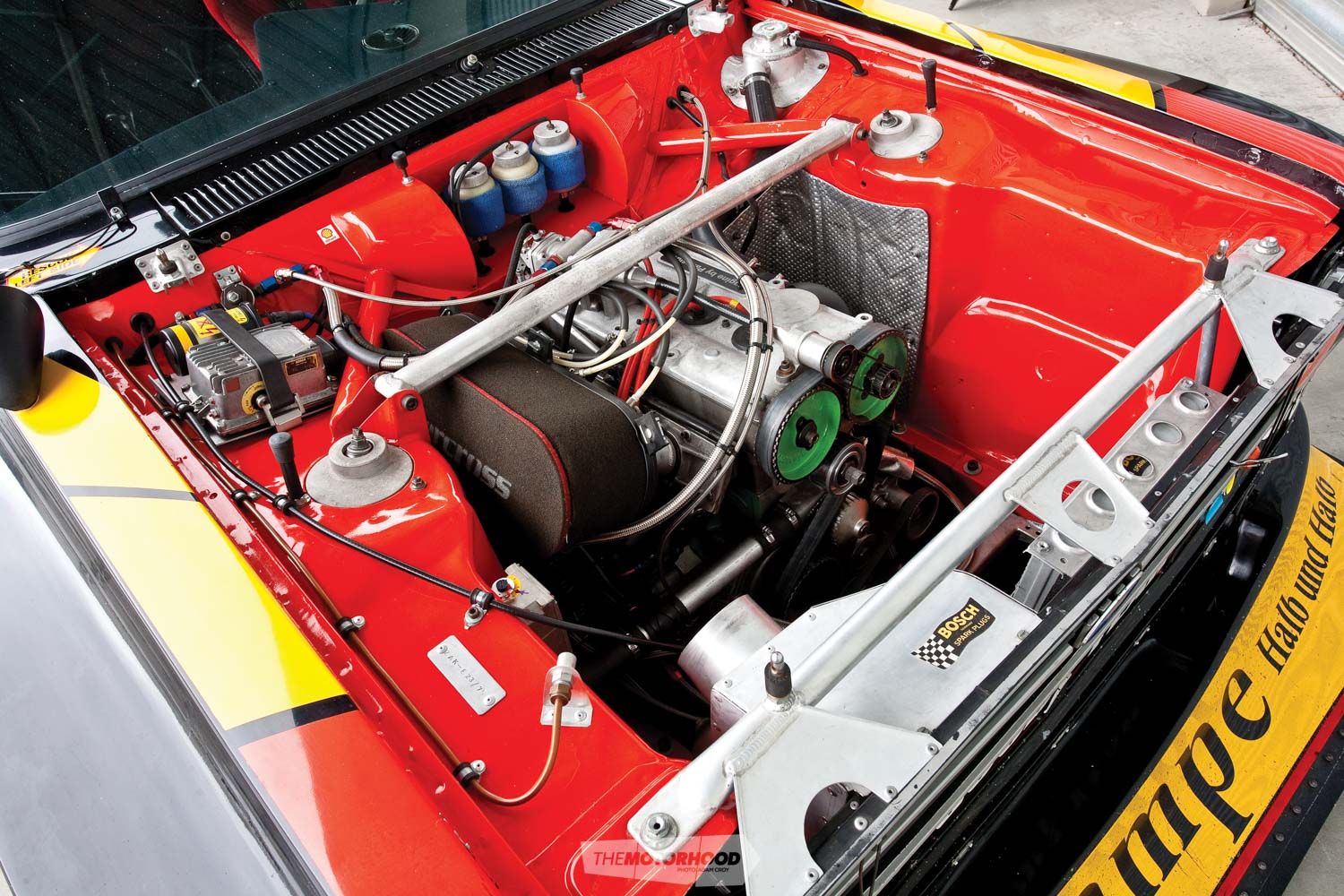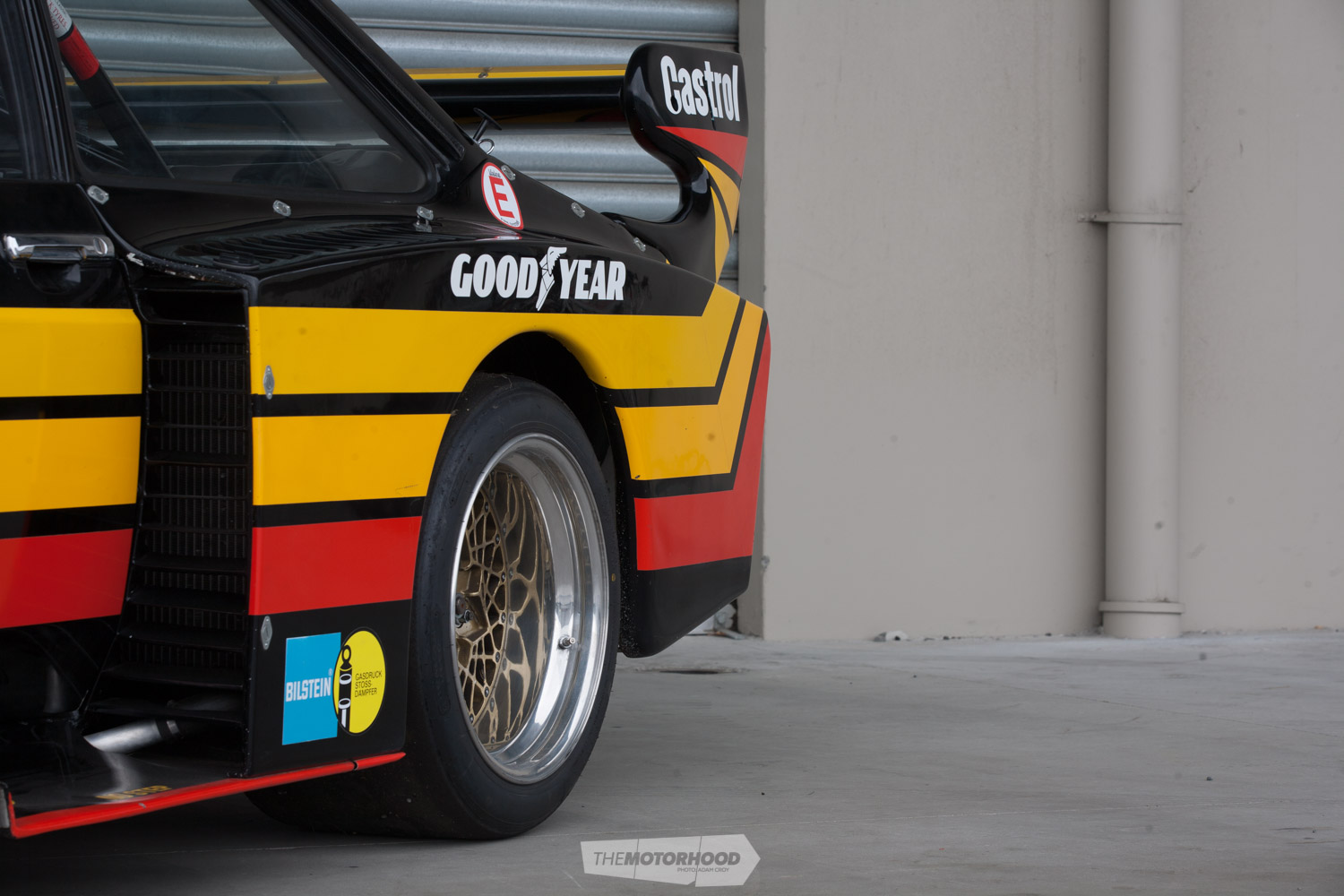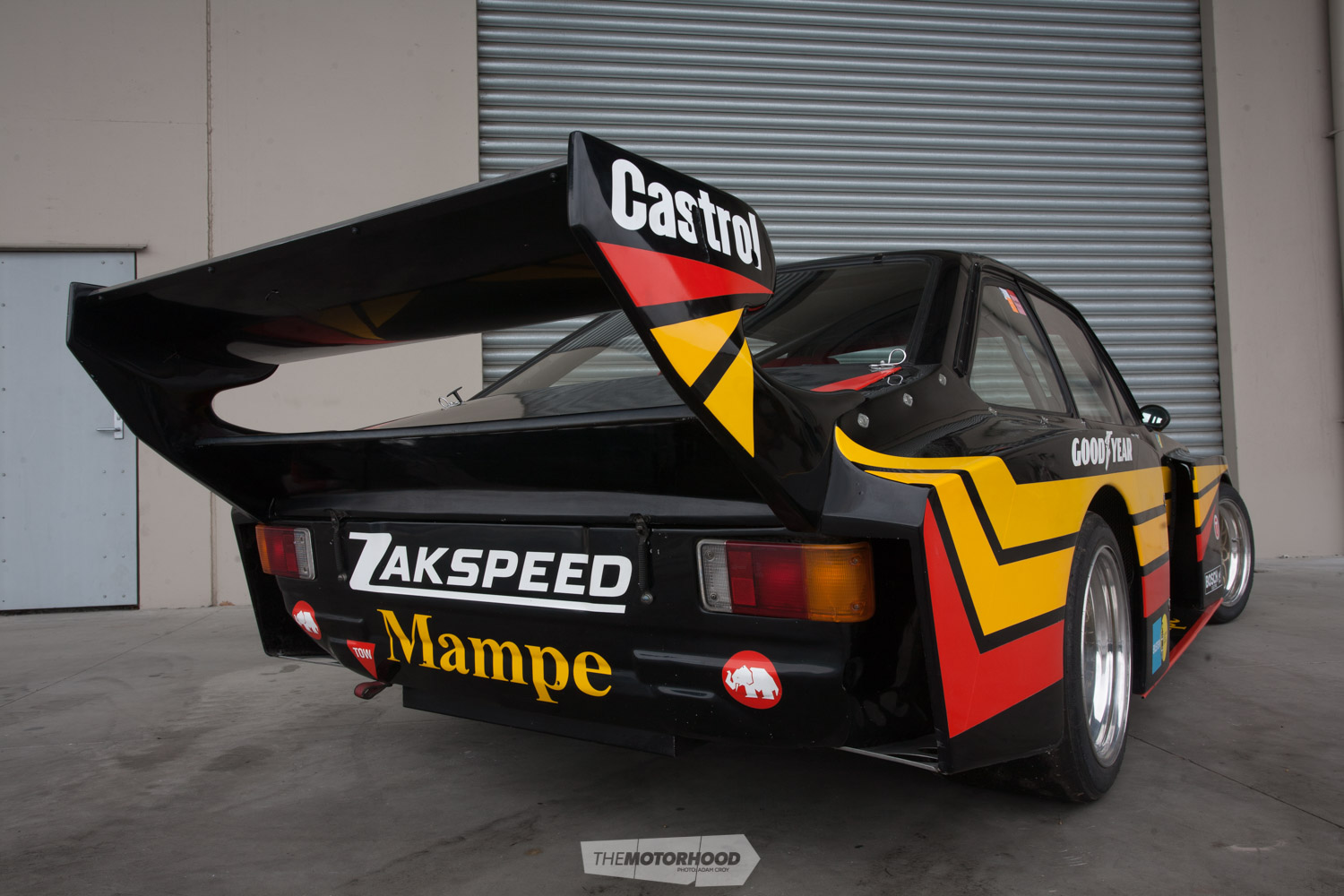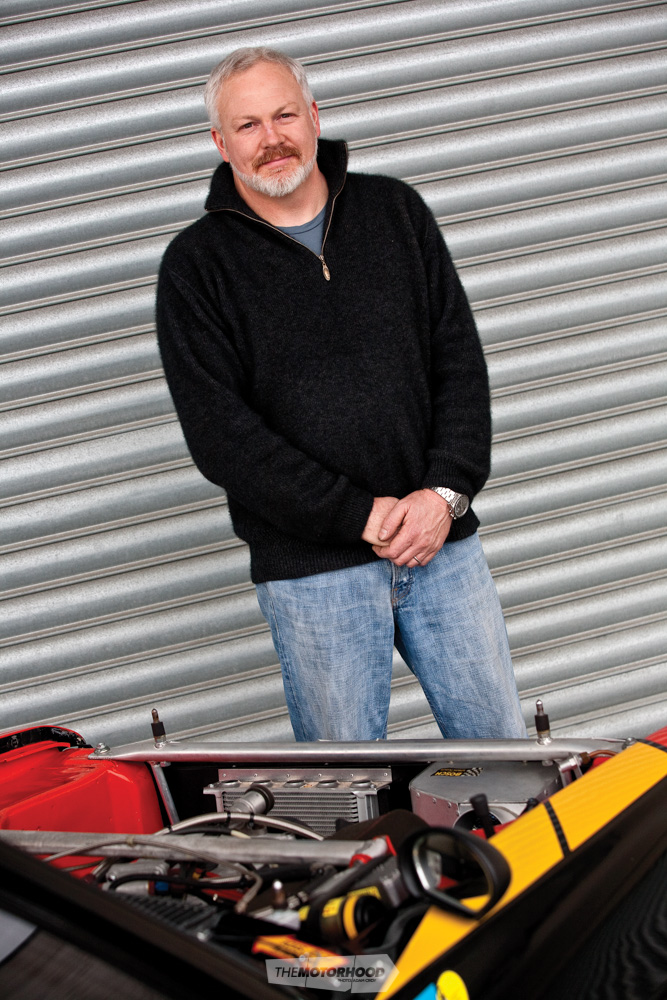This genuine ’70s race car is believed to be the only genuine Group 5 Zakspeed car competing anywhere in the world today, and, of course, it lives in the South Island

As predicted the crystal-clear blue skies we’d enjoyed during the first few days of our recent South Island trip soon gave way to dreary pea soup–like fog and drizzle as we arrived in Christchurch. However, we weren’t about to let a little bit of bad weather prevent us from photographing this magnificent machine and, to be perfectly frank, I’m darn sure our cameraman, Adam, would’ve been more than happy to stand out in a blizzard just to capture a few shots of Gary Wilkinson’s stunning Zakspeed Escort.
And yes folks, it’s the real deal, so I suggest you sit back, buckle up and enjoy the ride.
Racing in the Blood
It’s probably fair to say that Gary Wilkinson has motor racing genes swirling around in his blood. His father, Robin Wilkinson, raced everything from powerboats to go-karts and speedway, and is a life member of the Christchurch Car Club. As such, from an early age Gary remembers spending time with his father in the garage while he worked away on different projects. He also remembers spending many hours at Wigram, getting sun and windburn whilst intently watching Formula Pacific Ralt RT1s and RT4s screaming down the straights, and cheering his father on as he raced his Mini Seven.

Not surprisingly, at about the age of 10 Gary started racing go-karts, although after a few years he decided that wasn’t exactly the path he wanted to take as far as his motor racing career was concerned, instead opting for the gravel back roads. A Ford 105E Anglia was Gary’s weapon of choice – a car he and his father built up – and he soon started competing in local rallies. Obviously, dad was never too far away to proffer Gary a few words of advice.
Following a few seasons, the trusty old Anglia was starting to acquire a rather wrecked look while the inevitable battle scars were becoming more and more difficult, not to mention costly, to repair. Gary decided it was time for a change. He reckons by that time he’d figured out he wasn’t a terribly competent rally driver – in other words, he fell off the road with regular monotony.
By the age of just 17, Gary started to compete in circuit racing. The rallying experience and time spent building cars and engines with his father had stood him in good stead for this – especially as he’d just started an apprenticeship as an auto-electrician, which not only taught him about general electrical componentry in cars, but also the intricacies of electronics in engines, transmissions and, in later years, differentials (as basically they’re electronically controlled these days).

Gary would begin his circuit racing career at the wheel of his old rally Anglia, before graduating to a Ford Cortina and a Lotus Seven.
Seven Up
Away from the racetrack, Gary completed his apprenticeship and moved to Australia for a short while. Upon his return to New Zealand at the age of 23, he purchased an auto-electrical business with his father, Robin, and Chris Banks. Unfortunately, during the first couple of years the business struggled and the situation quickly became extremely frustrating for all three men. Looking for an antidote, they decided to form a company called Wilco Cars and constructed a car which they christened the Wilco 7. Today, Gary describes the Wilco 7 as a very accurate replica of a Lotus 7. Over a period of three to four years, Wilco Cars built and sold 13 completed cars and, as well, Gary raced one of them. The Wilco 7 also featured in very early editions of NZ Classic Car.
Gradually, during this same period, the trio’s auto-electrical business finally started to prosper. Around the same time, the Mazda MX-5 began to make an appearance in New Zealand, quickly gaining popularity with local sports cars drivers for its performance, handling and affordability. Both factors had a detrimental effect on the production of Wilco 7s and production soon ceased.

Following a careful inspection, Gary felt the car’s chassis tag – ZAK-E23/75 – indicated he was looking at a genuine Zakspeed Escort
At this time Robin was still racing his Mini Seven and, having just won the New Zealand Championship, he decided to hang up his helmet and gloves and move away from Mini racing, which provided an opportunity for Gary to test his skills behind the wheel of a Mini Seven. In fact, he was never keen on racing against his father, as he felt they were cut from the same cloth and both had a take no prisoners, no holds-barred attitude on the race-track. As such, they chose not to compete together.
Following his father’s retirement, for about the next eight years Gary continued to race Mini Sevens with Robin as his engine builder. Through sheer determination, he won the right to have his name on the same trophy as his father, after winning the Mini Seven South Island Championship as well as the New Zealand Championship for the 1998–99 season. This was a real achievement for Gary, and something he’d had his heart set on for some time – to see his name on the same trophy his father won five years earlier was indeed a proud moment for them both.
Singapore Sling
Gary continued racing his Mini Seven for just one more season and then decided it was time for a change. He had been in business with his father for 11 years, and in 2000 travelled overseas for a holiday, where he met a very nice lady who had taken a job in Singapore. They kept in contact for a short while before Robin and Gary decided to sell the business. Gary sold the Mini Seven, bought an engagement ring with the proceeds and moved to Singapore.

Once settled in Singapore with his soon-to-be wife, Gary secured a job with David Wong as test driver/engineer for his race cars. The job also involved the preparation of David’s race cars for race meetings, which in some cases involved a certain amount of re-engineering on models such as Type R Civics, Lolas and RX-7s. Gary was also involved in maintaining many other cars in David’s extensive collection – including the Ford Mondeo that Paul Radisich drove to victory in the British Touring Car Championship (BTCC) and 1993–4 Touring Car World Cup at Monza and Donington respectively, as well as Ford RS500s, Lotus 23s and the like.
However, after a while Gary came to the conclusion that test driving cars wasn’t really his thing. He found that in some respects it had become rather boring and mundane, and he felt he needed more action.
He then went to work for David Wong’s Team Petronas as chief engineer. For three and a half years, Gary worked as part of this great team, mainly racing Honda Civics in the Asia Touring Car Championship series throughout Asia at circuits in Malaysia, Philippines, Indonesia, Korea and China. Gary also had the opportunity to have a small stint with Sauber Petronas, the Formula One team, basically as an observer, before heading off to the UK to help set up Team Petronas for a three-year period competing in the British Touring Car Championship.

The Z-Car
In 2001, whilst working with the Petronas Team, Gary was introduced to a chap who showed him a ‘Z-Speed’ Escort, as they’re referred to in Asia. Gary, being a Ford man from way back and somewhat sceptical about the car he was about to see, had a basic understanding of what a Zakspeed Escort was and within 10 minutes of sighting the car knew in his heart that this was the real deal.
The car was housed in a dirty old shed, covered in junk and rubbish, at the bottom end of Malaysia in Johor, but the tell-tale signs were definitely apparent – such as unique to Zakspeed equipment, including the ZF gearbox, Atlas differential unit, magnesium uprights, BBS alloy wheels, competition Ford steering wheel and the use of Kevlar in some body panels. Following a careful inspection, Gary felt the car’s chassis tag – ZAK-E23/75 – indicated he was looking at a genuine Zakspeed Escort.
As Gary describes it, the car was basically in a wrecked condition but, believing there was a light at the end of the tunnel, he could imagine it in all its former glory. With his poker face on, Gary left the car that day and wasted no time in contacting Zakspeed in Germany, advising it of the chassis number. It responded by confirming the car was indeed the real deal, genuine and originally raced by Hans Heyer, who was considered to be one of the most versatile sports car and touring car drivers in the world during the 1970s and 1980s.

Now that Gary had confirmed what he’d already suspected, he went back 10 days later, negotiated a price to buy the car and immediately had it shipped back to New Zealand. Unfortunately, the day the car was loaded into a container, Gary took his wife along – as you’d expect, she wasn’t terribly impressed with what could only be described as a basket case. Indeed, the entire episode reduced her to tears, thinking her husband had gone completely mad wasting so much money on a total wreck.
Gary remained in Singapore until 2003 before returning to New Zealand, although he admits the long and lonely road of researching his new Zakspeed began the moment he purchased the car.
History File
Essentially, the Group 5 period of racing for Escorts lasted only for about 12 to 18 months from 1977, providing a very limited window of information on these cars before the introduction of the Ford Capri.
Subsequent research indicated that Gary’s Zakspeed was originally a Group 2 race car, which raced for two years prior to Group 5 and was then converted to Group 5 specifications. In total, five Group 5 Escorts were built by Zakspeed as factory works race cars. From what Gary has been able to ascertain, there are possibly only one or two still in existence – and the Zakspeed Escort you see in these very pages is, according to Gary, the only genuine Group 5 Zakspeed car competing anywhere in the world today.

Gary remembers spending time with his father in the garage while he worked away on different projects
Although Gary refers to his Zakspeed Escort as the Hans Heyer car, his research confirms it was also raced by Armin Hahne and Klaus Ludwig, who were all associated with Ford at that time. Gary also understands that the car was campaigned hard from 1975 to late 1977 and early 1978 throughout Europe, being the championship-winning car from 1975 as piloted by Hans Heyer, and runner-up in 1976 with Klaus Ludwig. From there, it was taken to compete in a non-European championship event in Macau.
Apparently Zakspeed always competed in Macau and Kyalami outside of Europe, and was known to sell cars whilst there, including this one, sold to Ford of Malaysia/ Haper Motor Group which employed the services of a young driver named Harvey Yap, a local up-and-coming Malaysian star, to drive the car. Consequently, the Zakspeed Escort gained some significant history in Asia throughout that period to complement its European career – all of which Gary found extremely difficult to research, as the habit of taking photographs and collecting data and documentation for specific races and cars wasn’t as prevalent as it is today.
Gary also managed to track down one of Zakspeed’s original engine builders, Rainer Bley, and was fortunate enough to have lengthy discussion with him about Zakspeed in the early days. Gary tried to obtain any information about his car and also asked about the chances of obtaining any memorabilia from the ’70s, only to be told that nothing was available – Zakspeed was so busy building, rebuilding and re-engineering cars that it never kept much information, especially on those cars that ended up in Asia.
Revival
Now that Gary and his wife were back in New Zealand, the process of deciding what to do with the Zakspeed Escort began with a complete strip-down – the only way Gary could make an informed assessment for the way forward. In actual fact, despite its poor condition the car was remarkably complete except for its running gear. A decision was made to effect a complete restoration.

Many of the car’s magnesium components – such as the suspension uprights, bellhousing and differential housing – had deteriorated due to moisture absorption, and had to be remade. New uprights were cast, magnesium wheels were imported from Germany and the ZF gearbox was completely rebuilt. The original roll cage was removed and copied down to the smallest detail, then reconstructed using much stronger chromoly tubing – a requirement for modern day motor racing. Fortunately Gary was able to track down an original engine block, from which Brent Buist from Palmside Automotive in Christchurch was able to rebuild a complete engine.
The BDG twin-cam engine retains its original 1975cc capacity and original Lucas 8mm fuel-injection system, producing 221kW (296bhp) and 238Nm of torque which, according to Gary, is more or less what the original Zakspeed Escorts were producing. The internals, such as conrods, pistons and crankshaft, are all new components because Gary has built the car to race hard and needs reliability.
In typical Kiwi style, Gary was keen to rebuild as much of the car himself as possible. He purchased MIG and gas welding equipment and chose to back himself by rebuilding most of the car himself. On reflection, he says it was extremely fulfilling that he could actually do the job required. Gary also reckons he didn’t have to be that clever to get the chassis right, Zakspeed did all the hard work back in 1977 and very little work to the steering geometry and suspension was required. Right from the outset the fundamental goal was to return the Zakspeed Escort to the condition in which it raced during 1977 and, when looking at the car today, it is an absolute credit to Gary’s tenacity and workmanship. On closer inspection even the Bosch HKZ ignition box is original, despite the fact it houses a late-model ignition system for improved reliability.

Subsequent research indicated that Gary’s Zakspeed was originally a Group 2 race car, which raced for two years prior to Group 5 and was then converted to Group 5 specifications
Gary has been so careful, as it was of the utmost importance to him to ensure every tiny aspect of the car would be exactly as it would have been when it was raced back in 1977 – and, except for seatbelts, seats and other safety items, it’s as close as you can get. There was a period of time when Gary anguished over whether or not to re-shell the car, but he very quickly came to the conclusion that this Zakspeed had far too much history to submit it to such sacrilege.
When the boot lid is removed – and you look down at the insides of the two rear guards – it’s still possible to see rows of old dodgy rivets where the Group 2 guards were attached to the body, something which can never be replaced. That’s history my friends, and that’s what makes this one very special car.
Back on Track
Gary does point out, however, that a project like this can quite easily destroy your soul. As the project progressed, many, many hours of hard work together with copious amounts of money all appeared to have been soaked up with little result – then, following a six-month break and a resurgence of enthusiasm, many pieces of the jigsaw finally fell together and Gary could finally see light at the end of the tunnel.
After seven years of hard work accompanied by periods of despondency and loss of motivation, a friend of Gary’s, Chris Davis, suggested they get the car out and on display – unfinished – at a Skope race meeting at Ruapuna. After a quick flurry of activity that included painting a few items and finishing a few things off, they were able to get the car to Ruapuna.
Gary was subsequently blown away by the response from both the race-going public and competitors alike – he was now beginning to realise he was the owner of a very special car, and that people needed to see it – a thought which provided all the motivation he required to complete the project.

A year later, Gary was on the grid for his first race meeting at Ruapuna for the 2010 Skope Classic. As is to be expected from a newly rebuilt race car, there were a few niggling mechanical issues, the worst of which was a broken crown wheel and pinion. Also, as Gary had been so particular about keeping the car as original as possible throughout the entire restoration, he had decided to weld a crack in the original bellhousing, and, of course, this eventually cracked again under stress, breaking the input shaft.
Since repairing these items, the car has proved to be a reliable competitor for the last race season – which included appearances at Hampton Downs for the NZ Festival of Motoring, the Lady Wigram meeting, the Skope Classic and the Southern Speed Fest at Invercargill. Gary reckons the Zakspeed Escort is an absolute joy to drive, the engine and suspension package work so well together that it’s just a matter of turning up to any race circuit, fuelling up and going racing. Gary and his team are skilled at staying on top of any issues that arise during race meetings, and he enjoys racing amongst other historic cars in historic touring car events throughout the country. As well, he continues to be overwhelmed by people’s response to the Zakspeed Escort, whether it be from other competitors or Joe Public who flock to see it, wanting to learn more about this very unique piece of motor racing history. Talking of history, Gary’s long-term objective is to take the car back to its original home, Europe, and drive it at the Nürburgring and Spa, two of the original circuits at which the car raced.
It’s just a dream at this stage, but that’s what dreams are made of, just as this car was a dream for Gary right back when he walked into a dilapidated and dirty old shed in Johor, Malaysia, and saw a very sad-looking Zakspeed Escort totally hidden by rubbish and debris. For Gary, the dream has come true – and, no doubt, his wife’s tears have now become tears of joy.

In typical Kiwi style, Gary was keen to rebuild as much of the car himself as possible









